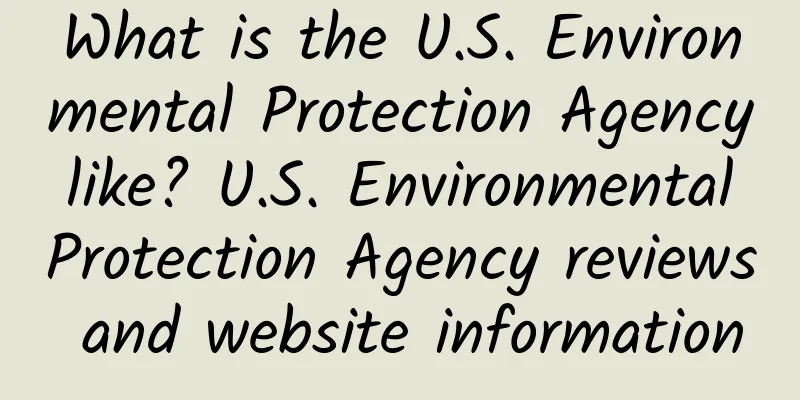What is the U.S. Environmental Protection Agency like? U.S. Environmental Protection Agency reviews and website information

|
What is the website of the United States Environmental Protection Agency? The United States Environmental Protection Agency (EPA) is a federal government agency of the United States established in 1970. It is mainly responsible for maintaining the natural environment and protecting human health from environmental hazards. Website: www.epa.gov U.S. Environmental Protection Agency (EPA): A pioneer in protecting nature and healthIn modern society, environmental protection has become a global focus. With the rapid development of industrialization and urbanization, environmental pollution has become increasingly serious, bringing unprecedented challenges to human health and the earth's ecosystem. In order to meet these challenges, many countries have established special agencies to supervise and manage environmental affairs. In the United States, such an agency is called the Environmental Protection Agency (EPA). As one of the core departments of the U.S. federal government, EPA has been committed to maintaining the natural environment, protecting human health, and promoting the concept of sustainable development since its establishment in 1970. The EPA official website ( www.epa.gov ) is an important window for the public to obtain environmental information and a key platform for understanding the agency's mission, policies and actions. Through this website, people can gain an in-depth understanding of the EPA's work, the law-making process, and how to participate in environmental protection. This article will detail the EPA's historical background, main functions, core projects, and its influence in the global environmental protection field, while also exploring the functions and value of its official website. EPA's History and BackgroundThe birth of the U.S. Environmental Protection Agency stems from the growing concern about environmental issues in the mid-20th century. In the 1960s, American society experienced a series of severe challenges such as increased industrial pollution, overexploitation of resources, and ecological damage. For example, the Cuyahoga River in Cleveland caught fire many times due to the accumulation of industrial waste, which caused shock and reflection across the country. At the same time, Rachel Carson's Silent Spring, published in 1962, revealed the potential threat of pesticide abuse to ecosystems and human health, further arousing public awareness of environmental protection. Against this backdrop, US President Richard Nixon signed an executive order in 1970 to formally establish the US Environmental Protection Agency. The establishment of the EPA marked the first time that the US government elevated environmental protection to a national priority. It integrated environmental regulatory functions that had previously been scattered across multiple government departments, including the management of air, water, land, and hazardous substances, to form a unified and efficient environmental agency. Since its inception, EPA has shouldered a dual mission: on the one hand, to reduce pollutant emissions and improve the ecological environment by formulating and enforcing strict laws and regulations; on the other hand, to help companies and communities achieve green development through scientific research and technical support. Over the past few decades, EPA has continued to grow and become one of the leaders in the global environmental protection field. The main duties and functions of EPAAs an important agency of the U.S. federal government, EPA has extensive and complex responsibilities. These responsibilities cover a wide range of areas such as air, water, soil, chemicals and waste, aiming to comprehensively protect the environment and human health. The following are some of the core functions of EPA:
By performing the above functions, EPA has not only achieved remarkable results domestically, but also set an example globally. For example, due to the efforts of EPA, the air quality in the United States has improved significantly in the past few decades, and the concentrations of pollutants such as sulfur dioxide and carbon monoxide have dropped significantly. In addition, EPA has successfully promoted many pollution control projects, such as cleaning up contaminated Superfund Sites, which has saved millions of residents from the harm of toxic substances. EPA's core projects and achievementsIn order to achieve its mission of protecting the environment and human health, EPA has launched and implemented a series of core projects with far-reaching impact. The following are some of the most representative projects and their achievements: 1. Clean Air ProgramAir pollution is a global problem, especially in industrialized areas. The EPA established the basic framework for controlling air pollution through the Clean Air Act and carried out a number of specific actions on this basis. For example, the National Air Quality Standards (NAAQS) set safety limits for six major pollutants (such as particulate matter, ozone, and lead) and required states to take measures to meet these standards. In addition, the EPA has launched the "Acid Rain Program" to reduce sulfur dioxide and nitrogen oxide emissions from coal-fired power plants. The program uses a market mechanism to allow companies to reduce overall costs by trading pollution rights while ensuring that emission reduction targets are achieved. According to statistics, since the implementation of the program, acid rain levels in the United States have dropped by about two-thirds. 2. Water resources protection planWater resources are the basis of life, but in recent years, water sources in many areas have been seriously threatened by pollution. To this end, the EPA has formulated the Clean Water Act, which clearly stipulates the standards for wastewater discharge and establishes a construction funding subsidy program for sewage treatment facilities. In addition to traditional point source pollution control, EPA also pays special attention to non-point source pollution problems, such as agricultural runoff and urban rainwater erosion. To this end, the agency launched the "Wetland Protection Program" to restore and protect wetland ecosystems and enhance their natural purification capacity, thereby effectively reducing pollutants flowing into rivers and lakes. 3. Hazardous Waste Management PlanImproper disposal of hazardous waste can cause serious harm to the environment and human health. EPA has established a complete hazardous waste management system through the Resource Conservation and Recovery Act, covering the entire process from generation to final disposal. The system requires all companies involved in hazardous waste to comply with strict reporting and record keeping systems and use standard technologies for treatment and storage. For the contaminated sites left over from history, EPA launched the famous "Superfund Program". This program has gradually restored thousands of contaminated land and waters by forcing the responsible parties to pay for the cleanup costs or by having the government pay for them. So far, millions of people have benefited from it and their living environment has been significantly improved. 4. Action to combat climate changeClimate change is one of the biggest challenges facing the world today. The EPA began to pay attention to greenhouse gas emissions as early as the end of the 20th century, and in 2009, it first identified carbon dioxide and other greenhouse gases as pollutants that threaten public health. Based on this identification, the EPA subsequently issued a number of policies to limit automobile exhaust emissions, improve energy efficiency standards, and promote the development of clean energy. Among them, the Clean Power Plan is a landmark initiative that aims to promote the transition from coal to natural gas and renewable energy by setting a cap on carbon emissions in the power industry. Although the plan was later suspended for political reasons, it demonstrated the EPA's determination and innovation in addressing climate change. EPA official website: a bridge for public participationThe EPA official website ( www.epa.gov ) is not only a window for the agency to show itself to the outside world, but also an important platform for the public to obtain information, participate in discussions and take actions. As a highly professional government website, the EPA official website has won wide acclaim for its rich content, intuitive design and powerful functionality. 1. Website Structure and NavigationThe EPA website adopts a clear hierarchical structure to facilitate users to quickly find the information they need. The homepage usually contains the latest news, hot topics and key links, such as air quality index, climate change data and drinking water safety reports. In addition, the website also has special columns for different groups such as ordinary people, business owners, researchers and policy makers. To enhance the user experience, the EPA website is equipped with a powerful search engine and filtering tools. Users can search for specific topics by keyword or filter relevant information by geographic location. This flexibility allows even first-time users to easily locate relevant content. 2. Educational resources and interactive functionsEducation is a major feature of the EPA website. The website provides a wealth of learning materials, including popular science articles, teaching videos, case studies and online courses. For example, the "Students Center" is designed for teenagers to explain environmental protection knowledge in a vivid and interesting way to stimulate their interest in nature. In addition, the EPA website also has a variety of interactive functions to encourage the public to actively participate in environmental protection. For example, the "Citizen Science Project" invites volunteers to collect local environmental data to provide first-hand information for scientific research; the "Green Living Guide" provides practical advice for families and individuals to help them reduce their carbon footprint in their daily lives. 3. Data disclosure and transparencyTransparency is one of the core principles of modern government websites, and the EPA website is particularly outstanding in this regard. The website regularly updates various environmental monitoring data, including air quality and water quality reports, greenhouse gas emission inventories, and the progress of contaminated site cleanup. These data are not only available to the public for review, but can also be downloaded for further analysis. More importantly, the EPA website also records in detail the policy-making process, including draft proposals, public comment solicitation, and the reasons for the final decision. This open attitude enhances public trust in the government and promotes a more democratic and inclusive decision-making process. EPA's influence in the global environmental protection fieldAs one of the earliest professional environmental protection agencies in the world, EPA enjoys a high reputation worldwide. Many of its policies and practices have been borrowed and imitated by other countries, becoming an important driving force for international environmental cooperation. First, the EPA has played a leading role in setting environmental standards. For example, the air quality standards and water pollution control technologies proposed by the agency have been incorporated into multiple international agreements and guidelines, providing a unified reference framework for environmental protection worldwide. Secondly, EPA actively participates in international organizations and multilateral talks to promote a broader consensus. For example, in the field of climate change, EPA works closely with the European Union, China and other major economies to jointly study feasible paths for a low-carbon economy. In addition, EPA also helps developing countries improve their environmental management through technical assistance and capacity building projects. Finally, EPA’s successful experience provides other countries with valuable learning opportunities. Many countries refer to EPA’s organizational structure and operation model when establishing their own environmental protection agencies. This knowledge dissemination not only promotes the overall progress of global environmental protection, but also deepens mutual understanding and trust among countries. in conclusionThe U.S. Environmental Protection Agency (EPA) is a benchmark agency in the global environmental protection field. Its establishment and development reflect mankind's profound understanding and firm commitment to environmental protection. From its initial single mission to today's comprehensive management of air, water, soil, chemicals and climate change, EPA has always been at the forefront of science and technology, constantly adjusting its strategies to adapt to new challenges. As a bridge between the public and environmental protection, the EPA website ( www.epa.gov ) not only provides a vast amount of information resources, but also creates numerous opportunities for participation, allowing everyone to contribute to building a better planet. In the future, as global environmental issues become increasingly complex, the EPA will continue to play its important role and lead us towards a more sustainable future. |
<<: What is Sarah Brightman like? Sarah Brightman reviews and website information
Recommend
How is Keek video social networking? Keek video social networking reviews and website information
What is Keek video social networking site? Keek is...
Ingredients and steps for making red dates and yam porridge
Red dates and yam are two common ingredients in l...
How to prevent diabetes in the elderly Methods and techniques to prevent diabetes in the elderly
As people's living standards improve, the inc...
Nutritional value of domestic red grapes
Speaking of red grapes, many people will think of...
The efficacy, function and medicinal value of honeydew melon
My daughter likes to eat honeydew melon. In fact,...
What is Neopets like? Neopets reviews and website information
What is Neopets? Neopets is a famous American pet ...
What are the benefits of eating pork liver?
Pork liver is the most important internal organ i...
The efficacy and function of yellow iris
Iris yellow is a perennial herb. What is special ...
The efficacy and function of red lentils
Lentils are a common vegetable in our daily life,...
Guitar Center_Guitar Center review and website information
Guitar Center_What is Guitar Center? Guitar Center...
How is We The People? We The People reviews and website information
What is We the People? We the People is a petition...
What are the benefits of coriander
Coriander is also known as cilantro, which is a v...
How are the Pittsburgh Penguins? Pittsburgh Penguins reviews and website information
What is the Pittsburgh Penguins website? The Pitts...
Will eating candied dates cause internal heat? What foods can't be eaten with candied dates?
Will eating candied dates cause internal heat? I ...
Watermelon smoothie recipe tutorial
I believe everyone is familiar with watermelon sl...









